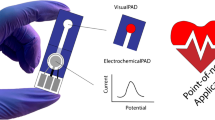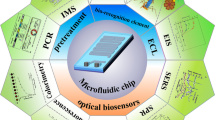Abstract
A label-free optical biosensor for detection and quantification of diclofenac in bovine milk has been developed. This was achieved by using reflectometric interference spectroscopy as detection method. In a first step, the immunosensor was developed and optimised in buffer concerning sensitivity, selectivity, stability and reproducibility. By comparing recovery rates—not only the good intra- but also the good inter-chip—reproducibility could be proven. Consequently, the assay was transferred in the more complex matrix milk. By utilising an optimised surface modification and evaluation method, matrix effects could successfully be prevented or circumvented. As a result, the developed immunosensor does not need sample pretreatment at all. By obtaining a limit of detection of 0.112 μg L−1 (0.108 μg kg−1), the capability of the developed biosensor is comparable or better than those of standard detection methods. Moreover, the presented biosensor reaches the range of the maximum residue limit (0.1 μg kg−1) set by the European Union. Thus, for the first time, diclofenac was successfully quantified at relevant levels in milk by using an optical biosensor.









Similar content being viewed by others
References
Kools SAE, Moltmann JF, Knacker T (2008) Estimating the use of veterinary medicines in the European Union. Regul Toxicol Pharmacol 50:59–65
Commission Regulation (EU) No 37/2010 of 22.12.2009 on pharmacologically active substances and their classification regarding maximum residue limits in foodstuffs of animal origin
Booth NH (1999) Veterinary pharmacology and therapeutics, 5th edn. Iowa State University Press, Ames, p 297
Lockwood PW, Johnson JC, Katz TL (2003) Clinical efficacy of flunixin, carprofen and ketoprofen as adjuncts to the antibacterial treatment of bovine respiratory disease. Vet Rec 152:392–394
Gallo P, Fabbrocino S, Vinci F, Fiori M, Danese V, Serpe L (2008) Confirmatory identification of sixteen non-steroidal anti-inflammatory drug residues in raw milk by liquid chromatography coupled with ion trap mass spectrometry. Rapid Commun Mass Spectrom 22:841–854
European Commission-Reference Laboratory for Residues of Veterinary Drugs (2001), Workshop NSAIDs and validation according to the SANCO/1805/2000, Berlin
Smith GW, Davis JL, Tell LA, Webb AI, Riviere JE (2008) Extra-label use of non-steroidal anti-inflammatory drugs in cattle. J Am Vet Med Assoc 232:697–701
Goodman Gilman A, Rall TW, Nies AS, Palmer T (1990) Goodman and Gilman’s: the pharmacological basis of therapeutics, 8th edn. Peragmon Press, New York
Roberts L, Morrow J, Hardman J, Limbird LE (2001) Goodman and Gilman’s: the pharmacological basis of therapeutics. McGraw-Hill, New York
Conaghan PG (2012) A turbulent decade for NSAIDs: update on current concepts of classification, epidemiology, comparative efficacy, and toxicity. Rheumatol Int 32:1491–1502
Sundlof SF, Kaneene JB, Miller RA (1995) National survey on veterinarian-initiated drug use in lactating dairy cows. J Am Vet Med Assoc 207(3):347–352
U.S. Code of Federal Regulations vol. 21, parts 520.1720, 522.1720
Dowling G, Gallo P, Malone E, Regan L (2009) Rapid confirmatory analysis of non-steroidal anti-inflammatory drugs in bovine milk by rapid resolution liquid chromatography tandem mass spectrometry. J Chromatogr A 1216:8117–8131
Dowling G, Malone E, Harbison T, Martin S (2010) Analytical strategy for the determination of non-steroidal anti-inflammatory drugs in plasma and improved analytical strategy for the determination of authorized and non-authorized non-steroidal anti-inflammatory drugs in milk by LC-MS/MS. Food Addit Contam 27(7):962–982
Dubreil-Chénau E, Pirotais Y, Bessiral M, Roudaut B, Verdon E (2011) Development and validation of a confirmatory method for the determination of 12 non steroidal anti-inflammatory drugs in milk using liquid chromatography-tandem mass spectrometry. J Chromatogr A 1218:6292–6301
Gentili A, Caretti F, Bellante S, Rocca LM, Curini R, Venditti A (2012) Development and validation of two multiresidue liquid chromatography tandem mass spectrometry methods based on a versatile extraction procedure for isolating non-steroidal anti-inflammatory drugs from bovine milk and muscle tissue. Anal Bioanal Chem 404:1375–1388
Jedziniak P, Szprengier-Juszekiewicz T, Pietruk K, Śledzińska E, Żmudzki J (2012) Determination of non-steroidal anti-inflammatory drugs and their metabolites in milk by liquid chromatography-tandem mass spectrometry. Anal Bioanal Chem 403:2955–2963
Peng T, Zhu AL, Zhou YN, Hu T, Yue ZF, Chen DD, Wang GM, Kang J, Fan CL, Chen Y, Jiang HY (2013) Development of a simple method for simultaneous determination of nine subclasses of non-steroidal anti-inflammatory drugs in milk and dairy products by ultra-performance liquid chromatography with tandem mass spectrometry. J Chromatogr B 933:15–23
Dowling G, Gallo P, Fabbrocino S, Serpe L, Regan L (2008) Determination of ibuprofen, ketoprofen, diclofenac and phenylbutazone in bovine milk by gas chromatography-tandem mass spectrometry. Food Addit Contam: Part A 25(12):1497–1508
Azzouz A, Jurado-Sánchez B, Souhail B, Ballesteros E (2011) Simultaneous determination of 20 pharmacologically active substances in cow’s milk, goat’s milk, and human breast milk by gas chromatography–mass spectrometry. J Agric Food Chem 59:5125–5132
Arroyo D, Ortiz MC, Sarabia LA (2011) Optimization of the derivatization reaction and the solid-phase microextraction conditions using a D-optimal design and three-way calibration in the determination of non-steroidal anti-inflammatory drugs in bovine milk by gas chromatography–mass spectrometry. J Chromatogr A 1218:4487–4497
Patel BK, Hanna-Brown M, Hadley MR, Hutt AJ (2004) Enantiomeric resolution of 2-arylpropionic acid non-steroidal anti-inflammatory drugs by capillary electrophoresis: methods and applications. Electrophoresis 25(16):2625–2656
Solangi AR, Memon SQ, Mallah A, Khuhawar MY, Bhanger MI (2009) Quantitative separation of oxytocin, norfloxacin and diclofenac sodium in milk samples using capillary electrophoresis. Biomed Chromatogr 23:1007–1013
Rodriguez-Mozaz S, Lopez de Alda MJ, Barceló D (2006) Biosensors as useful tools for environmental analysis and monitoring. Anal Bioanal Chem 386:1025–1041
Sharma H, Mutharasan R (2013) Review of biosensors for foodborne pathogens and toxins. Sensors Actuators B-Chem 183:535–549
Vidal JC, Bonel L, Ezquerra A, Hernández S, Bertolín JR, Cubel C, Castillo JR (2013) Electrochemical affinity biosensors for detection of mycotoxins: a review. Biosens Bioelectron 49:146–158
Deng A, Himmelsbach M, Zhu QZ, Frey S, Sengl M, Buchberger W, Niessner R, Knopp D (2003) Residue analysis of the pharmaceutical diclofenac in different water types using ELISA and GC-MS. Environ Sci Technol 37(15):3422–3429
Saini M, Taggart MA, Knopp D, Upreti S, Swarup D, Das A, Gupta PK, Niesser R, Prakash V, Mateo R, Cuthbert RJ (2012) Detecting diclofenac in livestock carcasses in India with an ELISA: a tool to prevent widespread vulture poisoning. Environ Pollut 160:11–16
Campanella L, Di Persio G, Pintore M, Tonnina D, Caretto N, Martini E, Lelo D (2009) Determination of nonsteroidal anti-inflammatory drugs (NSAIDs) in milk and fresh cheese based on the inhibition of cyclooxygenase. Food Technol Biotechnol 47(2):172–177
Markovic G (2008) Application of nanoparticles and optimized layer systems for signal amplification in reflectometric biosensors (dissertation), Tübingen, Germany
Moehrle BP, Kumpf M, Gauglitz G (2005) Determination of affinity constants of locked nucleic acid (LNA) and DNA duplex formation using label free sensor technology. Analyst (Cambridge, UK) 130(12):1634–1638
Brecht A, Gauglitz G, Nahm W (1992) Interferometric measurements used in chemical and biochemical sensors. Analusis 20(3):135–140
Piehler J, Brecht A, Gauglitz G, Zerlin M, Maul C, Thiericke R, Grabley S (1997) Label-free monitoring of DNA–ligand interactions. Anal Biochem 249:94–102
Rau S, Gauglitz G (2012) Reflectometric interference spectroscopy (RIfS) as a new tool to measure in the complex matrix milk at low analyte concentration. Anal Bioanal Chem 402:529–536
Dudley RA, Edwards P, Ekins RP, Finney DJ, McKenzie IG, Raab GM, Rodbard D, Rodgers RP (1985) Guidelines for immunoassay data processing. Clin Chem 31(8):1264–1271
Inczedy J (1998) Compendium of analytical nomenclature, 3rd edn. Blackwell, Oxford
Glaser RW (1993) Antigen-antibody binding and mass transport by convection and diffusion to a surface: a two-dimensional computer model of binding and dissociation kinetics. Anal Biochem 213(1):152–161
Kröger K, Jung A, Reder S, Gauglitz G (2002) Versatile biosensor surface based on peptide nucleic acid with label free and total internal reflection fluorescence detection for quantification of endocrine disruptors. Anal Chim Acta 469:37–48
Author information
Authors and Affiliations
Corresponding author
Additional information
Sabrina Rau and Urs Hilbig dedicate this article to Professor Günter Gauglitz on the occasion of his 70th birthday.
Electronic supplementary material
Below is the link to the electronic supplementary material.
ESM 1
(PDF 215 kb)
Rights and permissions
About this article
Cite this article
Rau, S., Hilbig, U. & Gauglitz, G. Label-free optical biosensor for detection and quantification of the non-steroidal anti-inflammatory drug diclofenac in milk without any sample pretreatment. Anal Bioanal Chem 406, 3377–3386 (2014). https://doi.org/10.1007/s00216-014-7755-2
Received:
Revised:
Accepted:
Published:
Issue Date:
DOI: https://doi.org/10.1007/s00216-014-7755-2




